Writing techniques like journaling, freewriting, and stream of consciousness can greatly ease anxiety. By letting your thoughts flow onto paper, you create a safe space for emotional expression. Journaling helps you process feelings and gain clarity, while freewriting allows for unfiltered expression, reducing mental clutter. Using guided prompts can focus your thoughts and foster self-awareness. Mindful writing grounds you in the present and enhances emotional regulation. Poetry and visual journaling also provide creative outlets for your feelings. These practices not only help manage anxiety but also pave the way for personal growth and deeper understanding. Want to uncover more techniques?
Benefits of Therapeutic Writing

Therapeutic writing offers numerous benefits that can help you manage anxiety and improve your overall well-being. By putting pen to paper, you create a safe space to express your thoughts and feelings without judgment. This process can lighten your mental load, allowing you to confront and process emotions that might otherwise remain bottled up.
As you write about your experiences, you gain clarity and perspective, enabling you to understand your triggers and reactions better. Writing regularly can also serve as a powerful release, reducing stress and providing a sense of relief. You'll find that articulating your worries can diminish their power over you, transforming overwhelming emotions into manageable ones.
Moreover, therapeutic writing enhances self-awareness. It helps you identify patterns in your thoughts and behaviors, which is essential for personal growth. With each entry, you might discover insights that lead to healthier coping strategies.
Understanding Journaling
Journaling can be a powerful tool for managing anxiety, offering you a safe space to express your thoughts and feelings.
It not only helps you process your emotions but can also provide clarity during stressful times.
Benefits of Journaling
Over time, many people have discovered that putting thoughts on paper can greatly reduce anxiety. Journaling offers a safe space for you to express your feelings without judgment. When you write, you're able to externalize your thoughts, which helps you gain clarity on what's bothering you. This process can lead to a deeper understanding of your emotions, allowing you to confront and manage them more effectively.
Another benefit of journaling is that it encourages mindfulness. As you focus on your thoughts and feelings, you become more present in the moment, reducing the tendency to ruminate on past anxieties or future worries.
Plus, it can serve as a powerful tool for problem-solving. By outlining your concerns, you can break them down into manageable parts and explore potential solutions.
Additionally, journaling fosters self-reflection, which promotes personal growth. You can track patterns in your thoughts and behaviors, helping you identify triggers and develop coping strategies.
Ultimately, journaling is an accessible, effective way to manage anxiety, providing you with a constructive outlet for your emotions and thoughts. So grab a pen and start writing; it might just be the relief you need.
Prompts for Anxiety Relief
Finding the right words to express your feelings can be challenging, especially when anxiety takes hold. Journaling can be a powerful tool for managing these feelings, but sometimes you need a little push to get started. That's where prompts come in. They help you focus your thoughts and bring clarity to your emotions.
Here are some prompts to help ease anxiety:
| Prompt | Purpose | Reflection |
|---|---|---|
| What am I feeling right now? | Identify emotions | Understand emotional triggers |
| What's one thing I can control? | Focus on the manageable | Shift perspective towards action |
| Write a letter to my anxiety. | Externalize feelings | Acknowledge and confront anxiety |
| List three things I'm grateful for. | Foster positivity | Shift focus from anxiety |
| What would I tell a friend in my situation? | Offer self-compassion | Provide perspective and support |
Using these prompts regularly can help you explore your thoughts and feelings, making it easier to navigate anxiety. By engaging with your emotions, you'll likely find relief and a deeper understanding of yourself.
Freewriting for Clarity
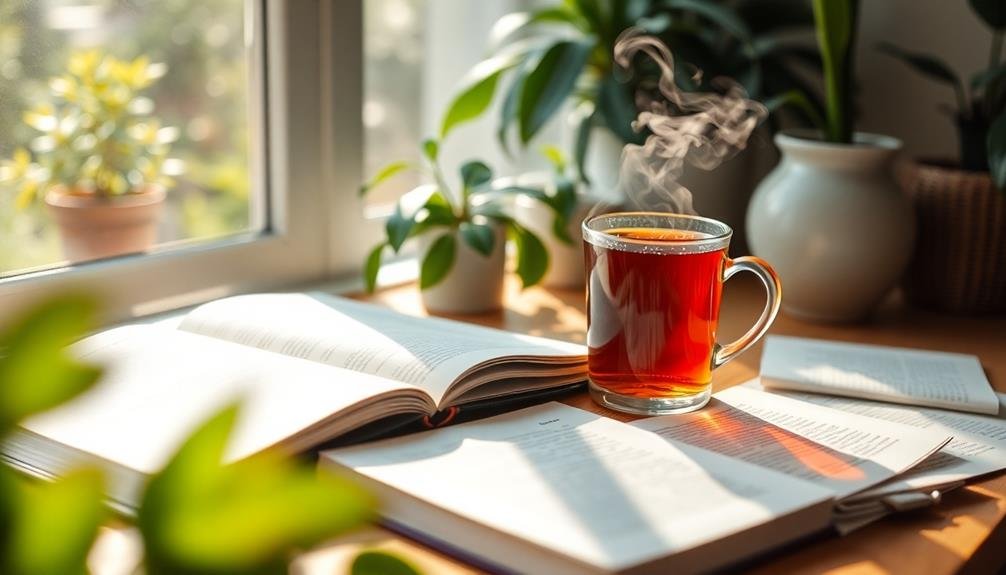
Freewriting can be a powerful tool to help you clear your mind and reduce anxiety. When you sit down to write without any specific direction, you create a safe space to express your thoughts freely. This process allows you to unload the mental clutter that often contributes to your anxiety.
Grab a pen and paper, or open a blank document, and let your thoughts flow without judgment. Set a timer for ten minutes, and don't worry about grammar or punctuation. Just write whatever comes to mind. You might start with your worries or emotions, but as you continue, you may uncover deeper insights or solutions to the issues troubling you.
This unfiltered writing can reveal patterns in your thoughts, helping you understand what truly bothers you. Once the timer goes off, take a moment to read through what you've written. You might find clarity in your feelings or identify specific sources of anxiety.
The act of freewriting not only helps you articulate what's inside but also reduces the weight of those thoughts. By making this a regular practice, you'll gradually cultivate a clearer mind and a more peaceful state of being.
Guided Journaling Prompts
Guided journaling prompts can be a powerful tool for managing anxiety and gaining clarity.
By using effective prompts, you can uncover your thoughts and feelings while benefiting from structured reflection.
Let's explore some examples that can help you get started on this journey.
Benefits of Guided Journaling
Clarity often emerges through the reflective process of guided journaling, where structured prompts help channel your thoughts and feelings. This technique offers several benefits that can greatly reduce anxiety.
First, it provides a safe space for you to express emotions that might be difficult to articulate otherwise. By putting your feelings on paper, you create distance between yourself and your worries, making them easier to manage.
Second, guided journaling fosters self-awareness. As you respond to prompts, you uncover patterns in your thoughts and behaviors, leading to deeper insights about what triggers your anxiety. This understanding allows you to confront and address these triggers more effectively.
Additionally, the structure of guided prompts can help you stay focused. You won't feel overwhelmed by a blank page, allowing you to concentrate solely on the topic at hand, which can ease feelings of being lost or scattered.
Effective Prompt Examples
Finding the right prompts can greatly enhance your journaling experience and further alleviate anxiety. Effective prompts encourage reflection and help you process your thoughts. Here are some examples to get you started.
- What's one thing you're grateful for today? Focusing on gratitude can shift your mindset and ease tension.
- Describe a time when you overcame a challenge. This helps you recognize your strengths and resilience, boosting your confidence.
- What's weighing on your mind right now? Writing about your worries can help clarify feelings and reduce their intensity.
- List three things you can do to take care of yourself this week. This encourages proactive self-care, promoting a sense of control.
- What's one positive affirmation you can tell yourself? Affirmations can counter negative thoughts and reinforce self-worth.
- What inspires you? Reflecting on sources of inspiration can uplift your mood and spark motivation.
Use these prompts to guide your writing sessions, allowing each one to lead you toward deeper insights.
Stream of Consciousness Writing
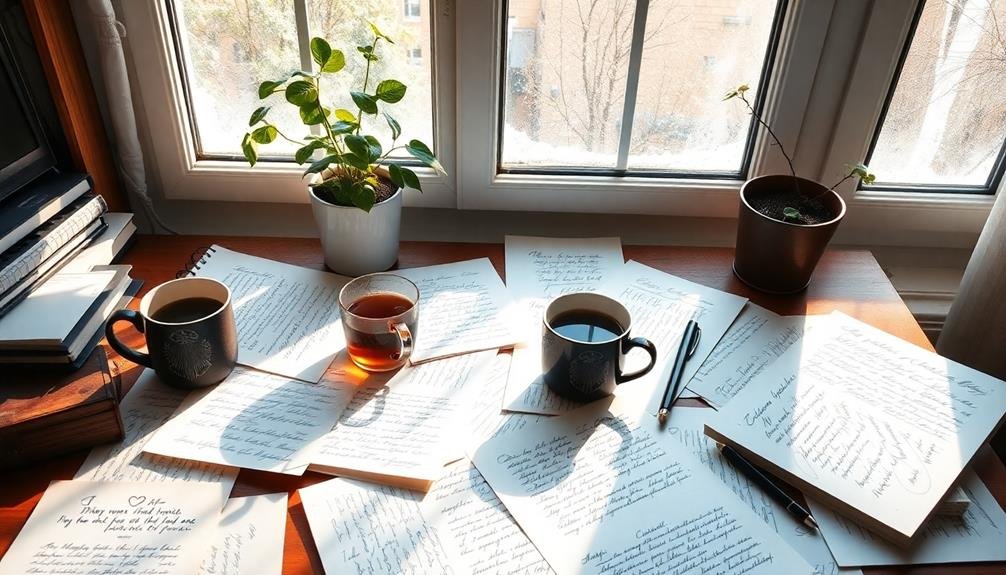
Have you ever tried letting your thoughts flow freely onto the page without any filters? This technique, known as stream of consciousness writing, can be a powerful way to ease anxiety. By allowing your mind to wander and your pen to move without restraint, you create a space where you can explore your feelings and thoughts without judgment.
When you engage in this practice, you might find that you uncover hidden emotions or unresolved issues that contribute to your anxiety. You're not focused on grammar, punctuation, or making sense; instead, you're simply letting everything spill out. This raw expression can be therapeutic, helping you release pent-up feelings and gain clarity about what's bothering you.
To start, grab a notebook or open a blank document. Set a timer for ten or fifteen minutes, and write whatever comes to mind. Don't stop to edit or second-guess yourself—just let it flow. You might be surprised by what emerges.
After you've finished, take a moment to read what you've written. This reflection can provide insights and help you process emotions that you didn't even realize were there.
Letter Writing for Closure
Sometimes, writing a letter can be the perfect way to find closure in a difficult situation. When you put pen to paper, you create a tangible expression of your feelings, allowing you to process emotions you might've kept bottled up.
This act can be incredibly therapeutic and provides a sense of release.
Here are a few tips to make your letter-writing experience more effective:
- Be honest: Write what you truly feel, whether it's anger, sadness, or gratitude. Honesty helps you confront your emotions.
- Avoid self-censorship: Don't worry about grammar or style. Just let your thoughts flow freely. This is for you, not an audience.
- Decide on delivery: You can choose to send the letter, keep it private, or even burn it as a symbolic gesture of letting go.
Creative Writing Exercises
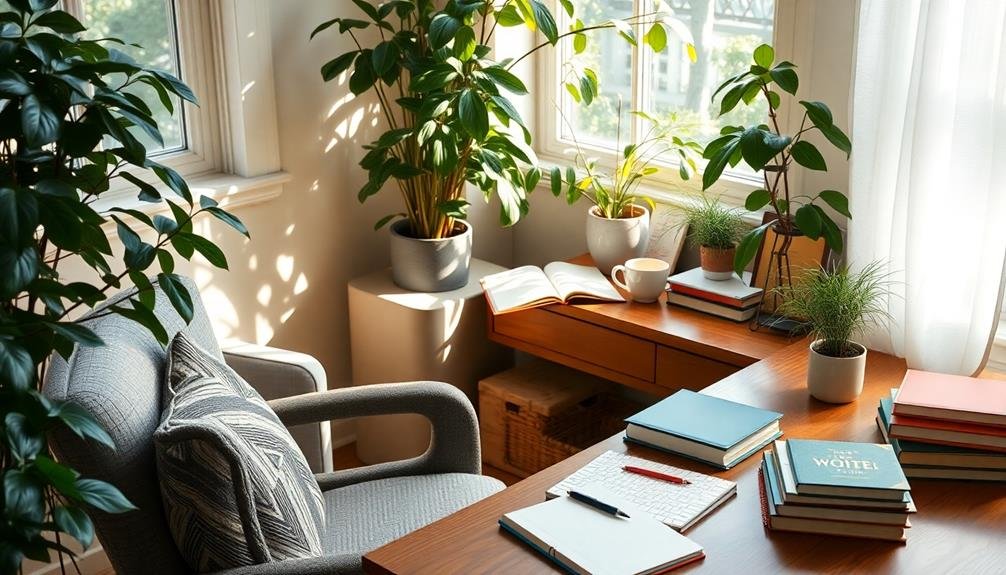
Creative writing exercises can spark your imagination and help you process your thoughts more effectively. You don't need to be a professional writer to benefit from these activities; all you need is a willingness to express yourself.
Start with free writing, where you set a timer for ten minutes and write whatever comes to mind without worrying about grammar or structure. This practice encourages you to let go of self-criticism and allows your feelings to flow.
Another effective exercise is character development. Create a fictional character and detail their background, motivations, and fears. This exercise not only ignites creativity but also helps you explore your own emotions by reflecting on your character's experiences.
You might also try writing prompts. Pick a random word or phrase and write a short story or poem based on it. This can challenge your mind and encourage you to think outside the box.
Lastly, keep a journal where you document your daily thoughts and feelings. This practice provides a safe space for your emotions and can reduce anxiety by allowing you to articulate what's on your mind.
Embrace these exercises, and you'll likely find comfort through creativity.
Mindfulness and Writing
Mindful writing can transform your experience by grounding you in the present moment.
By focusing on your thoughts and feelings without judgment, you can unfasten a sense of calm and clarity.
Let's explore the benefits and techniques that make mindful writing a powerful tool for reducing anxiety.
Benefits of Mindful Writing
Writing can serve as a powerful tool to ground you in the present moment, alleviating feelings of anxiety. When you engage in mindful writing, you focus your attention on your thoughts and feelings, creating a safe space to process them. This practice not only helps you understand your emotions better, but it also fosters a sense of calm.
Here are some benefits of mindful writing:
- Enhances self-awareness: You become more attuned to your thoughts, recognizing patterns and triggers that contribute to your anxiety.
- Promotes emotional regulation: By expressing your feelings on paper, you can better manage your emotions, preventing them from overwhelming you.
- Encourages creativity: Mindful writing can release your creative potential, allowing you to explore new ideas and perspectives that might shift your mood.
Incorporating mindful writing into your routine offers a unique way to connect with yourself. It invites you to observe without judgment, transforming your anxiety into clarity.
Techniques for Present Moment
Engaging in the act of writing while focusing on the present moment can greatly enhance your mindfulness practice. To harness this, start by setting aside distractions. Find a quiet space where you won't be interrupted.
Then, take a few deep breaths to ground yourself. This simple act prepares your mind for the writing experience.
Next, try free writing. Set a timer for ten minutes, and let your thoughts flow onto the page without judgment. Don't worry about grammar or structure; just focus on expressing your feelings and observations in the moment.
This technique helps you connect with your current emotions and thoughts.
Another effective approach is to use sensory details. As you write, pay attention to what you see, hear, smell, and feel in your environment.
Describing these sensations can anchor you in the present and reduce anxiety.
Poetry as Expression

Poetry can serve as a powerful tool for expressing emotions and easing anxiety. When you put pen to paper, you create a space where feelings can flow freely. Writing poetry allows you to articulate your thoughts in a way that's both creative and cathartic.
By engaging with language, you can transform your anxiety into something tangible and manageable.
Here are a few ways poetry can help you:
- Emotional Release: Writing poems provides an outlet for pent-up feelings, reducing stress and providing clarity.
- Self-Reflection: Poetry encourages you to explore your inner thoughts, helping you understand your emotions and identify triggers.
- Mindfulness Practice: Crafting verses can ground you in the moment, pulling your attention away from anxious thoughts and focusing on your creative process.
Whether you choose to write structured forms like sonnets or free verse, the act of creating poetry can help you navigate through your anxious feelings.
Visual Journaling Techniques
Exploring emotions through creative outlets can take many forms, and visual journaling is a fantastic way to express and manage anxiety. By combining art and writing, you can tap into feelings that might be hard to articulate.
Start by choosing a medium that resonates with you, whether it's colored pencils, markers, or watercolors. Let your creativity flow without worrying about perfection.
Begin each session by setting an intention, like exploring a specific anxiety or simply reflecting on your day. Use images, doodles, or collages that represent your emotions. You might draw your feelings or create a visual metaphor for what you're experiencing. Incorporating words, such as quotes or affirmations, can deepen your connection to the visuals.
Don't shy away from experimenting; the beauty of visual journaling lies in its flexibility. If you feel overwhelmed, try simple shapes or colors to convey your mood.
Over time, you may notice patterns in your emotions, helping you identify triggers and develop coping strategies. Visual journaling not only provides an emotional release but also allows for a deeper understanding of your thoughts, ultimately easing anxiety through artistic expression.
Setting a Writing Routine
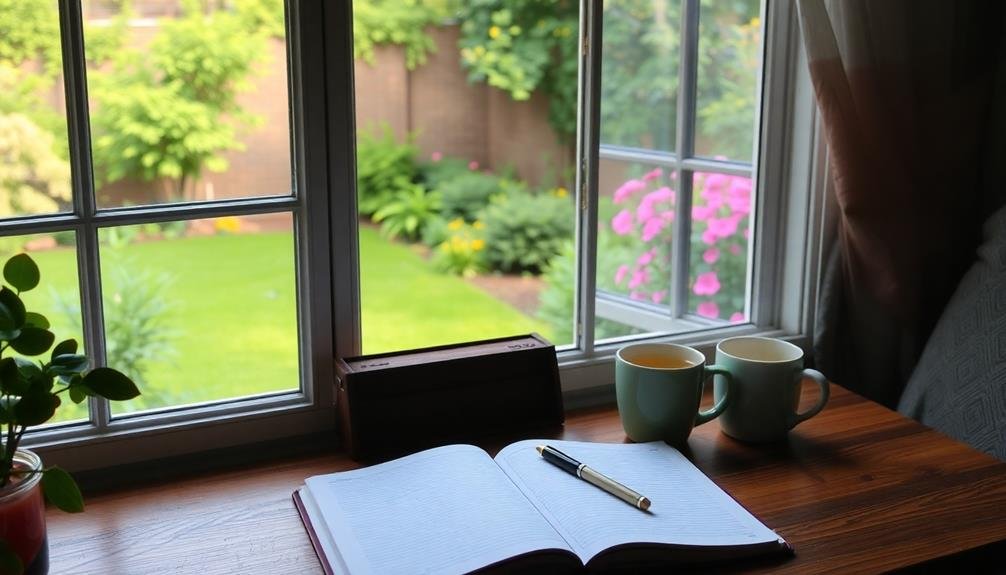
Establishing a writing routine can greatly reduce anxiety and enhance your overall well-being. When you commit to a regular writing schedule, you create a safe space for self-expression, allowing your thoughts and feelings to flow freely.
This predictability can help calm your mind and provide a sense of control over your creative process.
Here are some tips to help you set a writing routine that works for you:
- Choose a consistent time: Find a specific time each day that fits your lifestyle. Whether it's morning, lunchtime, or evening, stick to it to build a habit.
- Create a dedicated space: Designate a comfortable writing area to help you focus. This could be a cozy corner in your home or a quiet spot in a café.
- Limit distractions: Turn off notifications and set boundaries with others during your writing time. This will help you stay in the zone and make the most of your routine.
Frequently Asked Questions
Can Writing Techniques Replace Professional Therapy for Anxiety?
Writing techniques can't replace professional therapy for anxiety. While they're helpful tools for self-expression and reflection, trained therapists provide essential support, strategies, and understanding that writing alone simply can't offer. Prioritize getting professional help.
How Do I Start a Writing Practice if I'm a Beginner?
Starting a writing practice as a beginner's simple. Set aside time daily, grab a notebook, and write freely without judgment. Don't worry about perfection; just let your thoughts flow and enjoy the process.
What Materials Do I Need for Effective Journaling?
To get started with effective journaling, you'll need a good notebook or journal, a reliable pen, and a quiet space. It's all about creating an environment where you feel comfortable expressing your thoughts freely.
Are There Specific Topics to Avoid When Writing About Anxiety?
When writing about anxiety, it's best to avoid overly traumatic experiences, negative self-talk, or comparisons with others. Focus on constructive thoughts and personal growth instead; you'll find it easier to process your feelings positively.
How Can I Stay Motivated to Write Regularly?
To stay motivated, set small, achievable writing goals. Create a routine that fits your lifestyle, find inspiration in diverse topics, and reward yourself for progress. Remember, consistency builds momentum, so keep writing, even when it feels tough.
In Summary
Incorporating these writing techniques into your routine can greatly ease anxiety and promote emotional well-being. Whether you choose journaling, freewriting, or poetry, each method allows you to express your thoughts and feelings in a safe space. Remember, it's all about finding what resonates with you. So, grab your pen, create a cozy writing nook, and let your words flow. Embrace the journey of self-discovery and watch your anxiety transform into clarity and peace.
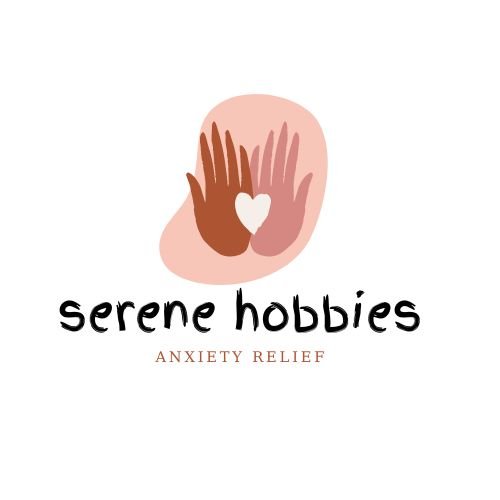




Leave a Reply